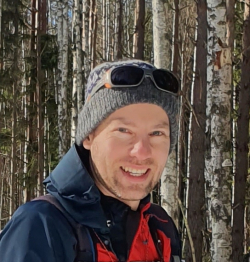What drives the composition of microbial communities?
Microbial ecology underlies both human health and the functioning of all ecosystems, yet it is still poorly understood. Its study has recently been revolutionized by the advent of high-throughput DNA sequencing, which can reveal the composition of naturally occurring microbial communities from environmental samples. Although these data offer considerable potential for our understanding of the microbial world, they are challenging to exploit and interpret. Our research aims at understanding the drivers of microbial community composition through the development of suitable statistical models.Published: 17.3.2022
Writer: Guilhem Sommeria-Klein
Header image: Christian Sardet, Tara Ocean Foundation
Microorganisms, or “microbes”, are the original form of life on Earth, and are accordingly ubiquitous and highly diverse. They live on the surface of all larger organisms, such as plants and animals, and play an essential role in their life cycle. It is, in particular, increasingly recognised that human health is tightly interconnected with the microbial communities living on human skin and mucous membranes (gut, mouth, respiratory tract, vagina, etc.). The composition of these communities, called “microbiota”, has recently been linked to a wide range of diseases, and to the adaptation of humans to their diet and environment. Microorganisms are also routinely put to use by humans, for instance, to treat wastewater and produce fermented food.
Microorganisms have arguably an even more profound impact on human health and well-being through the wide range of “ecosystem services” to which they contribute. They play a foundational role in all ecosystems by degrading organic matter and recycling nutrients. On land, they are a key component of soil productivity in forests, grasslands and agricultural fields. In oceans, they produce half of the oxygen in the Earth’s atmosphere, and they underpin the open ocean food web and the fisheries it sustains. Finally, the activity of microorganisms controls a large part of the global biogeochemical cycles, including the carbon cycle, and is, therefore, key to the release and storage of greenhouse gases.
Modeling the composition of microbial communities in large datasets
Microorganisms could until recently only be studied through in vitro culture, which is possible for only a small number of species and provides limited information on the microbial communities occurring in nature. As a result, the microbial components of ecosystems have long remained virtually unknown, despite their paramount importance to ecosystem functioning and human health. However, the study of microorganisms has undergone a revolution over the last 20 years thanks to the development of high-throughput DNA sequencing, which now enables the composition of microbial communities to be determined from any environmental sample. This has led to an ever-growing stream of data on microbial community composition from different environments, including soil, ocean and the microbiota of various host organisms.
Increasingly, the limitations to our understanding of microbial ecology lie not so much in the lack of data than in the lack of models to interpret them. With my collaborators, we aim at building statistical models for the ecological interpretation of large microbial datasets. We borrow modeling principles from disciplines faced with the analysis of similarly structured large datasets, as well as from classical ecology, since the fundamental ecological processes governing communities of micro- and macro-organisms are essentially the same. We rely on probabilistic models, that is to say, mathematical models that predict the probability distribution of outcomes rather than deterministic outcomes. Compared to popular “machine learning” approaches, such models have the capacity to explicitly account for ecological processes, while being amenable to statistical inference from data.
We apply the developed models to large datasets describing the composition of human gut microbiota and open ocean plankton. We aim to understand the structure, ecological role and dynamics of microbial communities in these ecosystems, and determine the drivers of their composition at different spatial and temporal scales. By studying ecosystems that are, in appearance, very different from one another, we seek to provide a unifying perspective on microbial ecology that will have important implications for societal issues as diverse as human health, the ocean food chain and the global carbon cycle.

Guilhem Sommeria-Klein is a post-doctoral researcher in the Department of Computing at the University of Turku. After studying physics up to the master’s degree, he obtained a PhD in ecology in 2017 from the University of Toulouse, France. His PhD thesis focused on linking theoretical ecological models and large environmental DNA datasets with application to soil biodiversity in tropical forests. He then studied the global drivers of eukaryotic plankton biogeography as a post-doctoral researcher at École Normale Supérieure in Paris, France.
Read more:
https://www.utu.fi/en/news/press-release/mapping-eukaryotic-plankton-globally-in-all-their-diversity
